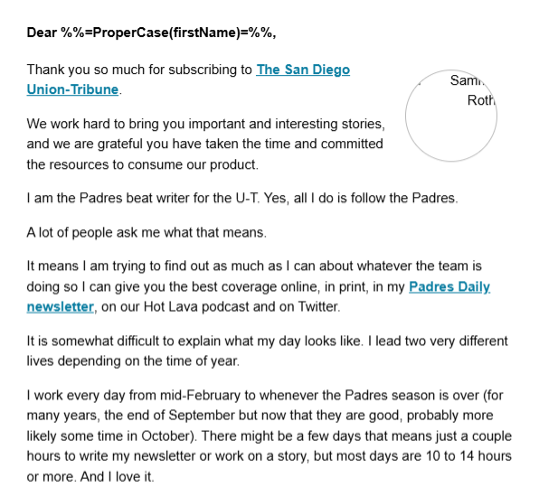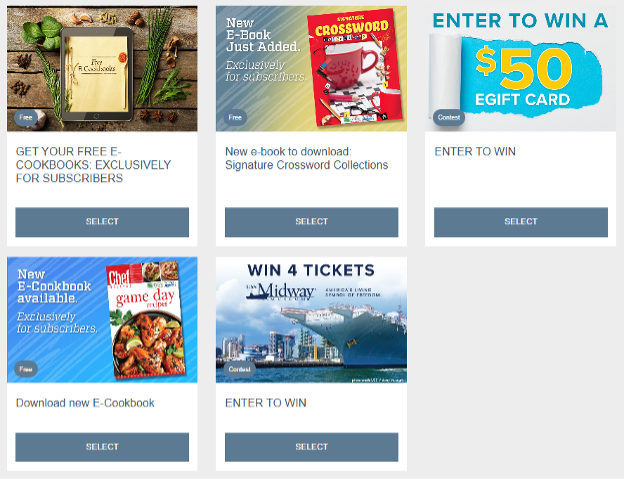5 strategies for retaining print and digital subscribers
Jan Ross P. Sakian, American Press Institute, Here’s an idea to steal and adapt: Build a reader rewards incentive to engage subscribers.
Here’s an idea to steal and adapt: Build a reader rewards incentive to engage subscribers. This is a series on Better News to a) showcase innovative/experimental ideas that emerge from the Knight-Lenfest Newsroom Initiative and b) share replicable tactics that benefit the news industry as a whole.
These insights were shared during a live Q&A session with alumni of the Table Stakes Local News Transformation Program in January 2025. This piece features tips from Anthony Basilio, director of subscriber revenue & analytics for The San Diego Union-Tribune, which participated in the 2020-21 Major Market Table Stakes Program.
This piece was one of Better News’ most viewed of 2025. Check out the full top 5 list here.
News organizations offering print and digital subscriptions balance a number of coexisting priorities: keeping subscribers engaged with the news content, growing audiences along with revenue and adapting processes for efficiency.
Anthony Basilio manages these strategic aspects and more as director of subscriber revenue & analytics for The San Diego Union-Tribune. In a January 2025 virtual Q&A session for Table Stakes alumni, Basilio shared case studies and offered tips on how news organizations can rethink monetization strategies with customer value in mind.
Ask questions to guide your sustainability strategy
Working at The San Diego Union-Tribune for more than 20 years, Basilio has seen the inner workings of multiple departments including circulation, finance, sales and distribution. He also managed transitions to new operating systems after the paper was bought by Alden Global Capital in 2023.
Basilio’s “week- to-week” responsibilities center on collaborating with partners and departments while also monitoring changes and growth in The Union-Tribune’s subscriber base. When making strategic recommendations on what to change and when to experiment, he asks these guiding questions to chart the path toward sustainability:
- In what ways is the subscriber base growing?
- In what ways is it declining?
- What are the factors that could be causing either the growth or the decline?
- What can we do better to manage our subscriber base?
- What are we doing on the acquisition side to support readers?
- Are we reaching communities in the way that we want to, to the extent that we want to?
- Are we reaching the targets that we think we need to meet?
More on this topic: Try these tactics to engage middle-funnel audiences
Streamline the billing process
The Union-Tribune’s subscriber retention strategies are rooted in efforts to make account management accessible for customers, which includes tools and systems to support customer relations staff.
For example, many customers still pay for their subscriptions through mail notices. The Union-Tribune recently added a “paper billing fee” to see if it encourages customers to pay online. Basilio notes that while the initiative is still young, they are seeing some migration to electronic payments.
Due to California’s strict rules for notifying subscribers about account changes like pricing and renewals, The Union-Tribune gives customers more time to respond to notices. They’ve also increased efforts to communicate with subscribers about their account status.
Other processes to support retention include:
- Sending a fourth and final renewal notice, when the set standard was previously three: These notices have more urgent messaging than the previous auto-reminders, reminding customers that they will lose access soon.
- A “digit report” in back-end systems showing the number of mailing notices a customer receives before they take action to renew: Timing between notices and the renewal method customers choose are also tracked.
- A “grace calling” effort using the company’s inbound call center to place outbound calls: The Union-Tribune uses a “lifetime value” metric to decide which customers get these calls, based on their location, price and subscription history. These customers receive two calls: the first early in their renewal grace period and another towards the end.
Basilio also developed a worksheet that agents can use to determine a range of prices to offer customers when they call to change or cancel a subscription. This tool helps give customers more affordable options while accounting for the company’s profit margin.
“We want to make sure that the pricing is right, such that it’s not so low that it costs us more to do the production and delivery,” he said. “Arming your agents with that type of information, I think, is very helpful and it gives them the opportunity to say, ‘you know, the lowest I can go is x. And that’s all I can do.’”
More on this topic: How The Seattle Times focused on subscriber retention as deliberately as on acquisition
Try a ‘buddy onboarding’ approach
The Union-Tribune welcomes new subscribers with first-person email “letters” written by reporters, providing subscribers with more insight into what it’s like to cover a beat. A second email is sent automatically after some weeks, highlighting new and relevant stories or evergreen content.
Basilio noted that colleagues named the strategy “buddy onboarding” because they wanted to make sure that people signing up knew that reporters were people, too, and their job is to provide information that subscribers want to read about.
Basilio said this has been a good opportunity to showcase work from various sections and highlight good journalism.
included their email or ways to reach them on social media — a sign that reporters were “all in” to see how their efforts can make a difference, Basilio said.

Example of an onboarding email from veteran sports reporter Kevin Acee, who covers the San Diego Padres baseball team
The Union-Tribune has initiated two rounds of letter “refreshes” to make sure new subscribers can experience different perspectives. Basilio said they recently received positive feedback on a particular letter featuring the “day in the life” of a reporter, which included:
- A re-introduction to the beat
- Links to stories covered
- More insight into the reporting process, like how to writer gets story ideas
More on this topic: How the Milwaukee Journal Sentinel drove subscriptions by asking journalists to promote the value of their work
Find ways to reward subscribers
In 2024, a collaboration with the Southern California News Group led The Union-Tribune to launch an online reader rewards program.
Subscribers have access to exclusive “perks” such as :
- Digital downloads (e.g., cookbooks, crossword puzzle collections)
- Opportunities to win gift cards
- Contests for access to local events and attractions (e.g., tickets to the USS Midway Museum)
Basilio said existing advertising and trade partnerships are helping them build up a range of offerings.

The Union-Tribune promotes reader rewards through email reminders, signaling where users can find subscriber perks in their “My Account” customer portal.
According to Basilio, data from the offering’s first six months showed that 20% of subscribers participating in member rewards had a tenure of only zero to six months. And 50% had a tenure of six months to one year.
“Customers that have renewed once or twice are also starting to take advantage of it,” he said. “It’s really shown us that it appeals to new and the older subscribers.”
More on this topic: How a 1-pound bag of coffee helped the Keene Sentinel reduce its digital subscriber churn
Gather data to fine-tune products
When The Union-Tribune wanted to assess the usability of their digital e-newspaper, they sought the help of volunteers from the community.
“We wanted to see: How many people are using it? Do they know how to use it? Do they know what features are there?” he said. “And surprisingly, we were able to just work with a local bookstore or a library to get some space and bring people in and we asked people to sign up.”
If a news organization is trying to launch a newsletter in a new market, Basilio suggests using focus groups to gain an understanding of the target audience’s needs and qualities.
And because “it’s always tricky to introduce paid models to things that are free,” consider starting a newsletter “on a voluntary basis” at no cost to early subscribers. By including an ask for support in the newsletter and an easy way for subscribers to contribute online, the product can begin to fund itself.
The Union-Tribune used this approach, using Press Patron to support their weekly community printed publications.
“On the website, there’s a little box that says, ‘support us,’ with any dollar amount you’d like to keep this coming to your inbox, to keep this coming to your driveway,” he said.
To set your revenue experiments up for success, Basilio recommends measuring your data and prioritizing methods for documenting the information to support decision-making.
“Get as much data as you can measure it, because if you’re not looking at it and you’re not measuring it, you really don’t know if it’s successful or if you could even act upon it or improve it in any way,” he said. “And of course, test as much as you can.”
More on this topic: How the Minnesota Star Tribune built relevance, one community at a time